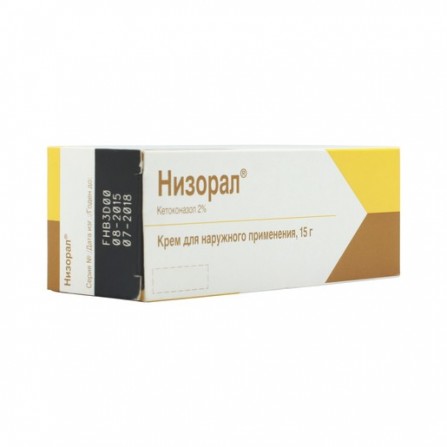More info
Active ingredients
Ketoconazole
Release form
Cream
Composition
Active ingredient: Ketoconazole Active ingredient concentration (mg): 20 mg
Pharmacological effect
Ketoconazole is a synthetic imidazole-dioxolane derivative, which has a fungicidal or mycostatic effect against dermatophytes such as Trichophyton spp., Epidermophyton floccosum and Microsporum spp., And against yeast, especially against Malassezia spp. yeast infections, with symptomatic improvement observed even before the first signs of recovery.
Pharmacokinetics
Concentrations of ketoconazole were not detected in the blood plasma of adult patients after topical application to patients after topical application of 2% Nizoral cream to the skin. In a study involving 19 children with seborrheic dermatitis, in which about 40 g of 2% Nizoral cream was applied daily to the surface of the skin 40% of the body surface, plasma ketoconazole concentrations were determined in 5 children and ranged from 32 to 133 ng / ml. With repeated use in children of cream 8 large quantities (more than 3 g), there is a likelihood of drug interactions inhibiting the metabolism of drugs metabolized by CYP3A4 enzymes, in particular cisapride, it is also possible to increase allergic reactions.
Indications
Arterial hypertension.
Contraindications
Known hypersensitivity to ketoconazole or any of the auxiliary components of the drug.
Use during pregnancy and lactation
Excessive use of the cream can lead to erythema, edema, and burning sensation, which usually disappear after cessation of therapy. In case of accidental ingestion, no action is required.
Dosage and administration
Candidiasis of the skin, dermatomycosis of smooth skin, inguinal athlete's disease, athlete's hand and feet, pityriasis versicolor: It is recommended to apply NIZORAL cream once a day on the affected skin and the immediate area. day, depending on the severity of the lesion. Treatment should continue for a sufficient period of time, at least for several days after the disappearance of all symptoms of the disease.The diagnosis should be reviewed if there is no clinical improvement after 4 weeks of treatment. General hygiene measures should be observed to control sources of infection and reinfection. The usual duration of treatment is as follows: pityriasis versicolor - 2-3 weeks, yeast infections - 2-3 weeks, inguinal athlete's disease - 2-4 weeks, dermatomycosis of smooth skin - 3-4 weeks, athlete's foot - 4-6 weeks. The usual duration of treatment is in case of seborrheic dermatitis - 2-4 weeks. For maintenance therapy with seborrheic dermatitis cream is applied once or twice a week.
Side effects
Precautionary measures
Overdose
Interaction with other drugs
special instructions
The data below summarizes the information on side effects registered during clinical trials, as well as data on the safety profile of the drug, obtained during its use in clinical practice. Side effects are grouped according to the classification of organs and organ systems MedDRA (medical dictionary for regulatory legal activity). Criteria for evaluating the frequency of side effects: very often (≥ 1/10), often (≥ 1/100 and <1/10), infrequently (≥ 1/1000 and <1/100), rarely (≥ 1/10000 and < 1/1000), very rarely (<1/10000, including individual messages). Since in the post-registration period, side effects are reported voluntarily from a population of uncertain size, it is not possible to reliably estimate the frequency of their occurrence, and therefore for these side effects “frequency unknown” is indicated. Violations of the immune system: rarely - increased sensitivity . Violations of the skin and subcutaneous tissues: often - burning skin; infrequently - bullous rash, contact dermatitis, rash, peeling of the skin, skin stickiness; frequency is unknown - urticaria. General disorders and disorders at the application site: often - erythema and itching at the application site; infrequently - bleeding, discomfort, dry skin, inflammation, irritation, paresthesia, reactions at the site of application. If any of the side effects indicated in the instructions are aggravated, or any other side effects that are not listed in the instructions are noted, you should immediately inform your doctor.




